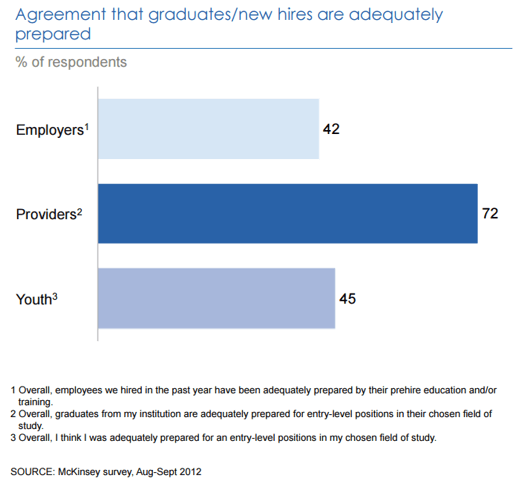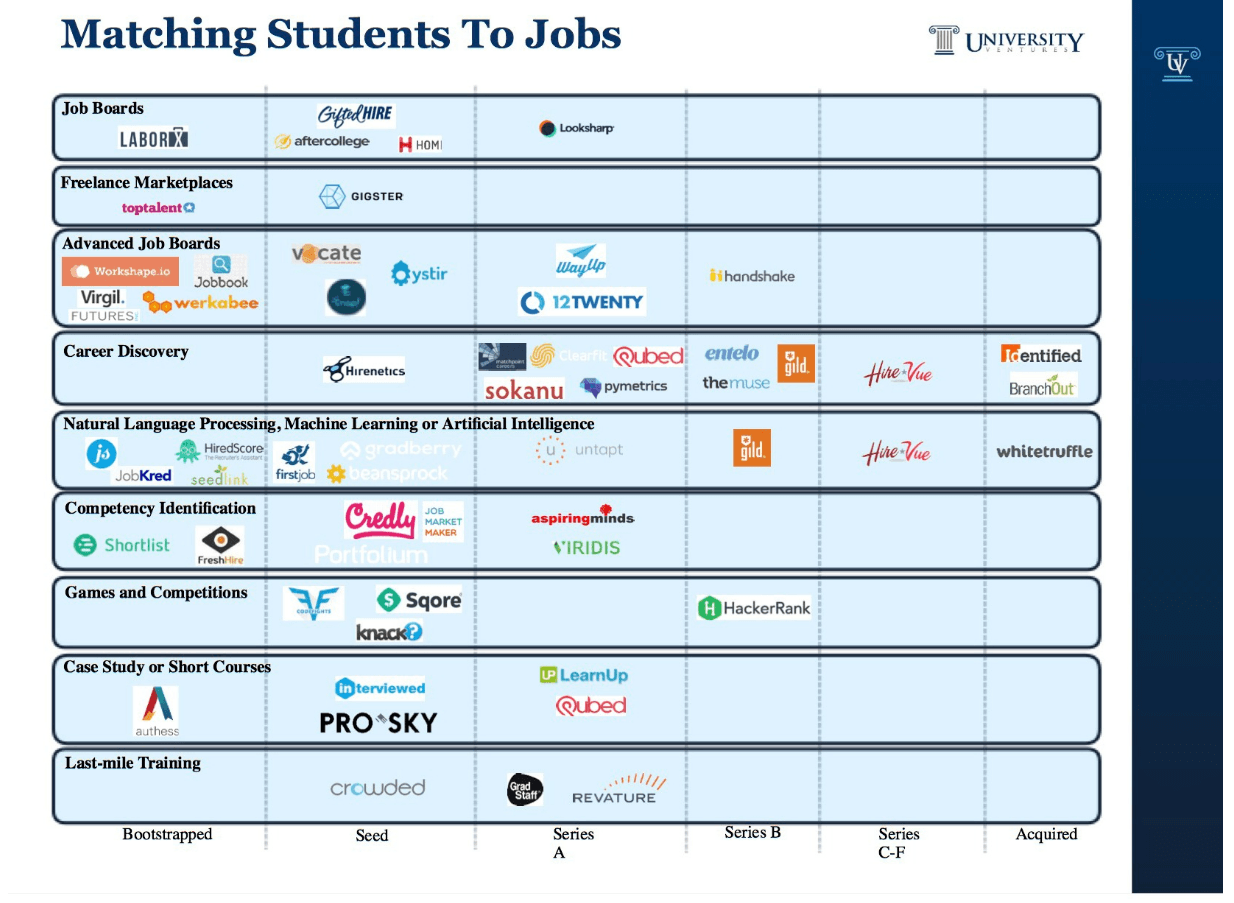Saving Generation Jobless through digitization

Are you young and looking for a job? Join the other 71 million youth unemployed in the world and trust that digital solutions will save the day.
The world is going through a youth unemployment crisis. On top of the 71 million youth unemployed, there almost three times as much underemployed[1]. Moreover, youth are three times more likely than their parents to be out of work[2]. Millennials are the first generation projected to earn less than its predecessor generation[3]. The main issue is that the crisis is affecting both developed and emerging economies and no-one has reached to a solution (see below[1]).That is why the UN has given a core role to reducing youth unemployment in its 2030 Sustainable Development Goals[4].
Although we definitely need to create more jobs (600 million in the next decade[1]). The crisis is mainly explained by a mismatch in supply and demand in the job market. Paradoxically, while there is an underutilized supply of people ready to work, ~40% of employers globally (the demand) struggle to fill in vacancies due to lack of skills in the workforce[5]. To close this skills gap, a robust education-to-employment (E2E) system is required. However, most of the programs worldwide lack scalability (serving thousands, not millions) and effectiveness (see below[2]). This is where digitization comes to play as digital solutions can increase both the scalability and effectiveness of E2E programs.
In terms of scalability, education providers have historically been constrained by space[2], teaching talent[2], and tools to match students with potential employers. In this context, several for-profit organizations have made progress through digital solutions, some examples below:
- Lack of space near to students: Udacity, an American for-profit, started an ambitious program using Massive Online Open Courses (MOOC), that allow them to reach students at very low marginal cost[2].
- Lack of teaching talent: IL&FS skills, and Indian for-profit, developed high-quality multimedia specifying best practices for entry-level jobs and distributed it to hundreds of thousands of students in their own training centers[2].
- Lack of matching tools: Digital solutions to match students to jobs is one active area of investment for private equities in education (see ventures below[6]). Authess is a particularly innovative one[7], bringing machine learning to analyze candidates before matching them with employers.
In terms of effectiveness, there has typically existed a trade-off with scalability as hands-on trainings have proven to be much more effective for training adults [2] but difficult to scale up. This means that the three scalable solutions provided above (MOOC, multimedia, lecture) may not be enough. It is then critical to find more interactive but scalable solutions and then implement through them the most effective curriculum and system.
Two new digital developments could fill this gap (be both scalable and effective) and are still in an early adoption stage:
- Serious Games (SG): Well-designed SG provide a self-immersive simulation that has demonstrated to be very effective at building cognitive hard skills (e.g., financial knowledge[8]) and socio-emotional skills[9] (e.g., teamwork) required by employers. In particular, socio-emotional skills are an example of something difficult to teach with a lecture and easier to teach with interactive tools. Many developers have started building games. One particular example is Glass Labs, who have created and enable several games that make learning visible (see below an example of a game for leadership skills)[10].
- Virtual Reality (VR): VR provides the ultimate hands-on learning experience, and although it may sound futuristic, there are some players already progressing in this topic. One example is EON reality, a company that has not only developed several solutions (see below an example of a VR training in ophthalmology), but also provides a platform to create customized VR trainings[11].
Due to its income level (upper-middle income[12]; not developed, not underdeveloped), one good example to assess the adoption stage of these technologies worldwide is Colombia. Colombia, as almost every country, is going through a youth unemployment crisis (50% of unemployed are younger than 29[13]) and its E2E system (called SENA) has adopted digitalization to scale up but still not widely implemented VR or SG solutions. In terms of scalability, SENA’s coverage has increased by effectively:
- Implementing 280 MOOC accessible throughout the country in a variety of industries (from agriculture to finance) [14]
- Using interactive multimedia and other hands-on platforms for students. One in solution in particular has been SENA’s Tecnoparque, a network of experts and laboratories to help people develop entrepreneurial ideas[15].
- Setting up online tools for student registration and employer matching[16].
Although SENA has not yet fully leveraged SG nor VR due to cost/language barriers, it has created software development courses to teach students how to build VR and SG[17]. This sends the signal that SENA will soon count with in-house digital solutions.
The bad news is that if this is the case for Colombia, it is likely that lower income countries are even more lagged in the adoption curve. The question then is, is it too late? Have we already lost a Generation?
Word Count: 796
[1] International Labor Organization. World Employment Social Outlook. Trends for youth 2016. http://www.ilo.org/wcmsp5/groups/public/—dgreports/—dcomm/—publ/documents/publication/wcms_513739.pdf
[2] McKinsey & Company: McKinsey Center for Government. Education-to-employment: Designing a system that works.
[3] Gardiner, Laura. Resolution foundation. Intergenerational commission report. Stagnation Generation. The case for renewing the intergenerational contract. 2016
[4] UN. Sustainable Development Goals 2030. Goal 8. http://www.un.org/sustainabledevelopment/economic-growth/
[5] ManPower Talent Shortage Survey 2016-2017/ Infographics report. http://www.manpowergroup.com/wps/wcm/connect/389b7a9d-cfe2-4b22-bd61-f0febc709cd6/2016_TSS_Global_Infographic+-+Final.pdf?MOD=AJPERES. Accessed, November, 2016
[6] EdSurge News. Who’s playing matchmaker between students and employers?. https://www.edsurge.com/news/2016-07-29-who-s-playing-matchmaker-between-students-and-employers. Accessed, November, 2016
[7] Authess. Our technology. http://www.authess.com. Accessed, November, 2016
[8] Earp et al., 2014. Supporting human capital development with serious games: An analysis of three experiences. Computers in Human Behavior, 30 (2014), pp. 715–720
[9] Victor Lim-Fei, Huey Ming Woo, and Ming Yew Lee. Ministry of Education of Singapore. Serious Games to Develop Social and Emotional Learning in Students. Serious Games. Second Joint International Conference, JCSG 2016, Brisbane, QLD, Australia, September 26-27, 2016, Proceedings
[10] Glass Lab Games Web Page. http://www.glasslabgames.org/. Accessed, November, 2016
[11] EON Reality Web Page. http://www.eonreality.com/. Accessed, November, 2016
[12] World Bank. World Data Bank. List of economies. databank.worldbank.org/data/download/site-content/CLASS.xls. Accessed, November, 2016.
[13] EL TIEMPO (online newspaper). http://www.eltiempo.com/economia/finanzas-personales/desempleo-en-colombia-la-mitad-son-jovenes/16578803. Accessed, November, 2016
[14] SENA. Virtual courses catalogue. http://portal.senasofiaplus.edu.co/index.php/component/content/article/513-cursos-virtuales-sena. Accessed, November, 2016
[15] SENA. Tecnoparque. http://tecnoparque.sena.edu.co/. Accessed, November, 2016
[16] SENA. Sistema de Gestion Virtual de Aprendices. http://caprendizaje.sena.edu.co/SGVA_Diseno/pag/login.aspx. Accessed, November, 2016
[17] SENA. Press room. http://www.sena.edu.co/sala-de-prensa/escrita/Paginas/Noticias/Realidad-virtual-que-SENA-ofrece-a-sus-aprendices-es-real.aspx. Accessed, November, 2016
*Blog coverphoto taken from publication of The Economist (http://www.tomorrowtodayglobal.com/2013/05/09/generation-jobless-a-warning-to-us-all-2/) , TIME picture by Christian Als (http://christianals.com/author/als/page/8/) , and Generation Jobless from Peter Vogel (http://www.generationjobless.eu/). Acessed, November, 2016.









Very interesting topic! It opened my mind understanding that a major challenge of unemployment is actually a quality challenge (the difficulty to match job to talent) and not only the quantity (number of jobs available).
I wonder, however, if people looking for a job will go through this time and effort of self learning when no one promise them they will find a relevant job, there is a risk most of them will just continue looking of a job that doesn’t require additional skills, and the same loop continues… Maybe the companies mentioned should try and include an agreement with potential employers, to promise a future employment (even if time limited) and therefore encourage those potential workers to put this time and effort.
Another questions rises about costs- who pays for these trainings? the unemployed? the government? I wonder if someone that has no income will be willing to pay for those skills or look for less efficient sources that are free.
Very educational blog. Thank you for taking the time and effort to bring this sensitive topic to the forefront of our conversation.
One concern I have is that increased education might not fix the job gap. I’m concerned that we aren’t teaching the skills for actual jobs that exist. For example, welders and machinists are in high demand but we don’t teach those skills in highschool or college? Perhaps vocational schools could use this new tech to get front and center and raise awareness for important work that needs to get done.